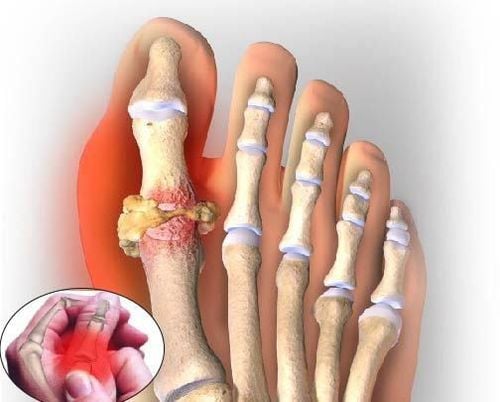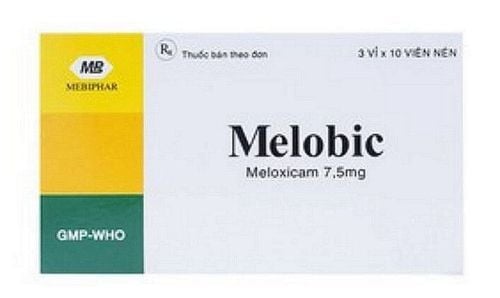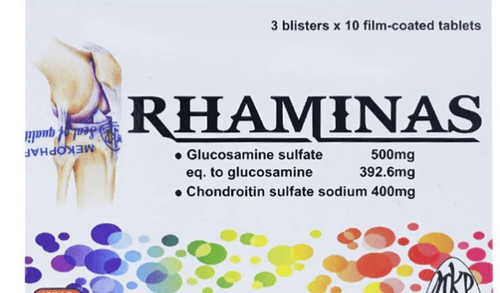This is an automatically translated article.
Glucosamine is a natural substance found in healthy joint cartilage of the human body and is formulated into a pharmaceutical product. Treatment of osteoarthritis with glucosamine helps relieve symptoms of chronic knee osteoarthritis.1. Osteoarthritis disease
Osteoarthritis is a chronic disease caused by the destruction of joint fluid, causing the bones to lose their cushioning and rub against each other. This long-term condition leads to stiffness, difficulty in movement, pain and limitation of movement of the body. The disease mainly affects the joints of the knees, hips, arms, legs as well as the spine. Some of the risk factors associated with osteoarthritis include:
Aging; Fat; Sedentary, exercise; Injury; Sex. Statistically, osteoarthritis is the most common cause of disability in developed countries. About 9.6% of men and 18% of women over 60 are facing symptoms of joint pain; 80% of patients have limited mobility, and 25% of people with osteoarthritis are unable to perform daily activities of life.
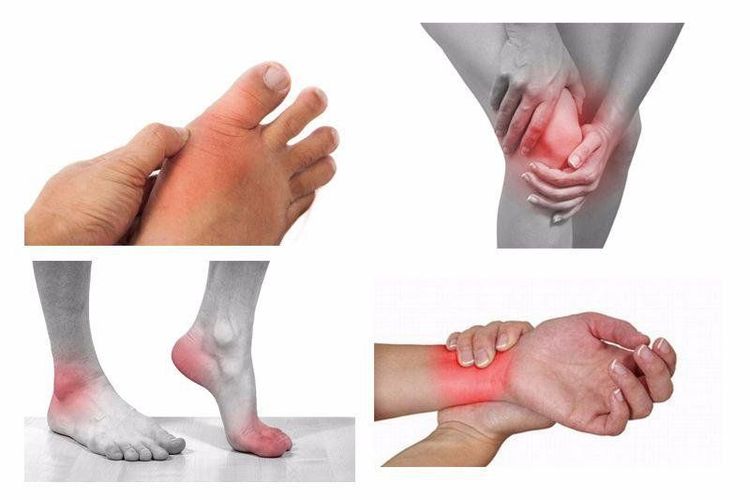
Viêm xương khớp là nguyên nhân gây mất khả năng vận động
2. What is Glucosamine?
Glucosamine is an amino - mono - saccharic of endogenous origin, produced by the body but decreases with age. Glucosamine is also a component that helps synthesize glycosaminoglycans that make up cartilage tissue in the body. In addition, glucosamine is also derived from shells of shrimp, crabs and marine animals.Glucosamine can be indicated in the treatment of a number of diseases such as:
Osteoarthritis; Arthritis, rheumatoid arthritis ; Degenerative spine ; Spinal spines ; Interstitial cystitis ; Inflammatory bowel disease (IBD); Multiple sclerosis (MS); Glaucoma ; temporomandibular joint (TMJ). In many cases, the drug will bring the best effect when combined with chondroitin (chondroitin sulfate is a component of joint cartilage, bones, skin, cornea and artery walls).
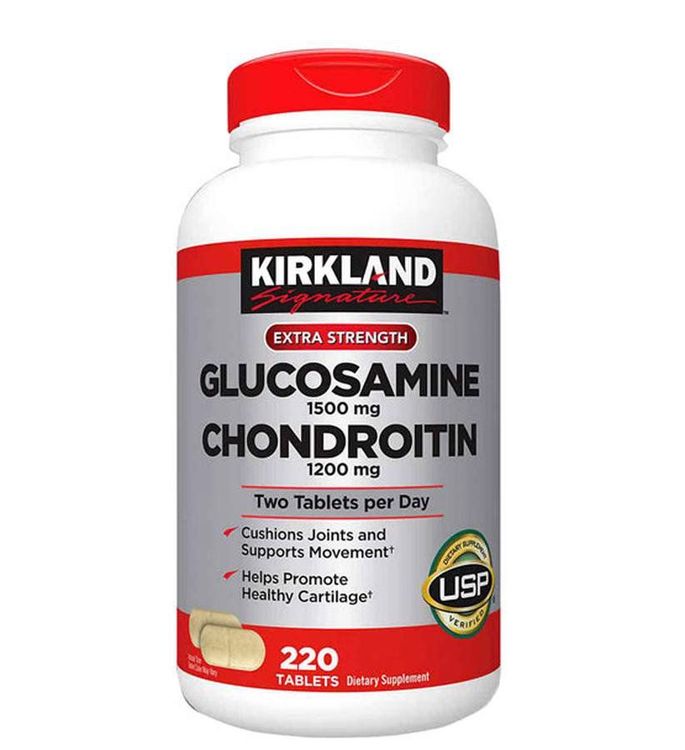
Glucosamine có thể được chỉ định trong điều trị một số bệnh lý như thoái hóa khớp
3. Effective treatment of osteoarthritis with glucosamine
Glucosamine and salt forms are widely used in the treatment of bone and joint diseases. On the market today, there are many health support preparations that combine glucosamine with other ingredients such as chondroitin, vitamins, minerals and medicinal herbs.
Previous studies have shown that glucosamine is safe and effective in reducing pain, as well as improving function for patients with osteoarthritis. However, later randomized analyzes concluding the potential benefits of glucosamine may have been overstated. A series of recent studies have not confirmed the effects of glucosamine and chondroitin sulfate (either alone or in combination) in patients with osteoarthritis.
In general, there have been mixed opinions about the effectiveness of glucosamine treatment for osteoarthritis. In fact, most of the positive studies are funded by the manufacturers of glucosamine preparations, while the majority of neutral scientists have not found a therapeutic effect of this active substance.
Because the effectiveness of glucosamine treatment for osteoarthritis is still not fully convincing, this product is only circulated as a "dietary supplement" in some countries. The FDA agreed to publish "Dietary Supplements with Crystallized Glucosamine Sulfate Reduces Osteoarthritis Risk" on the label. In addition, the British National Formulary 59 also mentioned glucosamine to help "relieve symptoms of mild and moderate knee arthritis".
Thereby, it can be concluded that glucosamine cannot replace orthodox osteoarthritis drugs. Moreover, the use of glucosamine does not always bring positive results, the effect of glucosamine osteoarthritis treatment is still a matter of continuing controversy. Therefore, when there is a need to use glucosamine-containing products, both prescribers and patients should consider all factors, especially between the economic benefits and the unclear therapeutic effects of this drug.

Glucosamin không thể thay thế được các loại thuốc điều trị viêm xương khớp
4. Some notes when taking glucosamine
4.1. Types of glucosamine preparations The variety of glucosamine preparations used in treatment includes:
Glucosamine sulfate; Glucosamine hydrochorid ; N-Acetylglucosamine. Among them, the sulfate salt form - extracted from shellfish, is the most used in studies and can bring positive effects in the treatment of osteoarthritis with glucosamine. Therefore, healthcare professionals and consumers must pay attention to information about the other two forms of glucosamine on product labels.
4.2. Contents On the market today, there are also many types of glucosamine prepared with very different concentrations, including:
Tablets 250mg; Powder or oral solution 1.5g; Solution for injection 400mg/3m. In most studies, a total dose of 1200-1500 mg of glucosamine was given to adults in three divided doses per day. If glucosamine is combined with chondroitin, the recommended dose is 1200 mg and also divided into 3 times/day. Usually, patients need to take a course of 2-3 months and repeat treatment every 6 months. In the event that after the end of the course, there is no improvement in symptoms, the patient should stop taking the drug and consult a doctor.

Người bệnh không nên tự ý sử dụng các loại thực phẩm chức năng
4.3. Origin The glucosamine products circulating on the market are produced from many different sources, so the quality is not the same. For example, in the US, glucosamine is only classified as a functional food, so it will be less rigorously censored in terms of quality. While glucosamine preparations originate from Korea, India, Taiwan, Malaysia,... and are widely appearing in the Vietnamese market, little research has been done on their effects and effectiveness as well as in the Vietnamese market. their quality.
4.4. Side effects During the treatment of osteoarthritis with glucosamine, patients may experience some side effects such as:
Digestive disorders; Nausea, vomiting; Headache; Rash; Heartburn; Stomach pain; Sleepy; Bleeding easy...

Glucosamin có thể gây tác dụng phụ đau đầu cho người dùng
4.5. Other notes The drug can affect blood sugar and insulin levels, so people with diabetes should consult a doctor before use; Glucosamine can interact with some other drugs such as: Antipyretic and pain reliever Paracetamol, medicine to treat hyperlipidemia, heart medication... Pregnant and lactating women, as well as minors should not take Glucosamine without your doctor's prescription; People with a history of allergy to any ingredient of the drug should inform their doctor before taking Glucosamine; The drug should be discontinued at least 2 weeks before any surgical procedure (including dental surgery). In summary, there has not been any really clear evidence about the effectiveness of glucosamine in the treatment of osteoarthritis, so this is still a controversial issue. If there is a need for use, patients need to keep in mind some notes when taking glucosamine in terms of dosage form, content as well as origin, quality of the product... Like other drugs, the use of glucosamine The right dose and enough time as prescribed by the doctor also play a very important role, helping to bring good changes to the symptoms of osteoarthritis.
Please dial HOTLINE for more information or register for an appointment HERE. Download MyVinmec app to make appointments faster and to manage your bookings easily.






